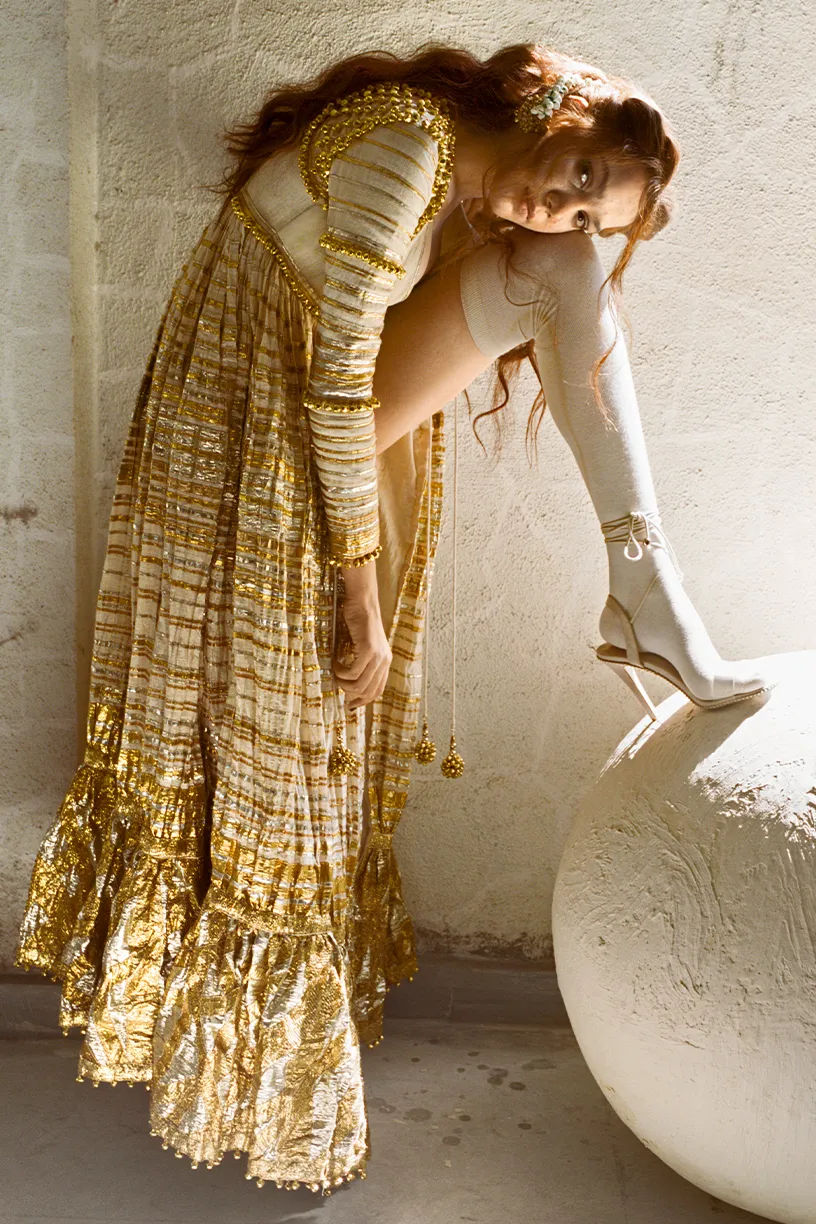
WHY KHADI IS ONE OF THE MOST SUSTAINABLE FABRICS TO CONSIDER RIGHT NOW
Designers are changing the perception of the textile that was once the symbol of India's freedom struggle to a sustainable fabric that belongs to the runway
BY JASREEN MAYAL KHANNA
10 January 2020
Khadi played an important role in our nation’s history—a lot of us grew up learning about how Gandhi made the spinning charkha a national symbol during the freedom struggle. He called for a boycott of British textiles to embrace the ancient craft traditions of our own country, the foremost being khadi. Technically, khadi can refer to any natural fabric that is hand-spun and handwoven, be it cotton, silk, jute or wool. While mill-made cloth is essential to satisfy the textile demands of the Indian market, khadi is a precious craft deeply intertwined with India’s story. More importantly, it is highly sustainable.
The spinning of khadi uses no machines or energy and thus has a low carbon footprint. A metre of khadi fabric consumes three litres of water, while one metre of mill-produced fabric requires 55 litres of the precious resource. Plus, khadi clusters also generate direly needed income to rural Indian communities.
Historically, khadi played a role in helping India free itself from the rule of its colonisers. Today, it is part of the solution for the major environmental crisis the world is facing. With sustainable fashion now becoming part of mainstream conversations, Indian consumers have become open to embracing clothing made out of eco-friendly raw materials. Thus, various organisations, brands and designers are giving this humble fabric a modern makeover to keep it relevant in 2020. In fact, in the last few years, the textile has made incredible strides both commercially and aesthetically.
Government organisations like The Khadi & Village Industries Commission (KVIC) and the Ministry of Micro, Small and Medium Enterprises (MSME) have been giving the textile a serious push since 2018, showcasing the cloth internationally and signing memorandums with institutions like NIFT for better design development and training. According the the KVIC, the total average khadi sale was Rs 914.07 crore from 2004 to 2014, and has jumped to Rs 1,828.3 crore between 2015 to 2018, highlighting over a 100 per cent increase. The number of stores have also grown from 7050 in 2017 to 8087 in 2018, with new formats like shop-in shops.
Big menswear textile brands like Peter England and Raymond have been working with clusters to release khadi collections, and Arvind Ltd has invested heavily to create khadi denim, one of the most sustainable denim variants in the world. Even luxury designers are going out of their way to embrace khadi in their designs and thus giving it a contemporary avatar. There were a few early adopters. Designer Ritu Kumar has been using khadi for over a decade and is known to have praised for its eco-friendly properties, matte texture and ability to dye beautifully. However, it’s fair to say that the biggest and brightest proponent of khadi is designer Sabyasachi Mukherjee, who has used it in almost all his collections. Mukherjee used this “poor man’s cloth” to craft bridal ensembles that look like they could be worn by royalty. On his Instagram account, he says, “As a bridal designer, I keep thinking, ‘What's next?’, and I keep coming back to khadi. For me, it is the equivalent of wellness, and nothing can be more luxurious than that.” Few know that early in his career, Mukherjee won best designer at a contest called Khadi Goes International, which won him a scholarship to go to London (also his first international trip) and an internship with the Victoria and Albert Museum.
Even internationally, the fabric is gaining recognition. This humble fabric was the subject of an exhibit by Issey Miyake at the 21_21 Design Sight in Tokyo and showcased again in 2019 at the brand’s New York store. Rahul Mishra used khadi in his collection for Paris Fashion Week 2019; the quirky, cool collection inspired by school uniforms has nearly 80 per cent of its graphic textile handwoven used using khadi yarns. KVIC has taken it to South Africa, Russia and New York (at the 63rd session of the Commission on Status of Women by the United Nation's Economic and Social Council) as part of its promotional strategies.
Designer Payal Jain believes that khadi can be fashionable and used to create a variety of cool silhouettes including western, Indian, and even couture; she herself has used khadi to make bold prints, jumpsuits and even gowns. Anju Modi has used it to create fusion silhouettes like peplum kurtas with dhotis while Rohit Bal has crafted bridal lehengas out of it. Khadi is also being combined with other Indian crafts; Raghuvendra Rathore has combined it with dori work, Abu Jani Sandeep Khosla have combined it with chikankari, label Metaphor Racha has done modern hand dyeing with khadi. Popular websites like Jaypore, Aijo and sustainable fashion website, Ikkivi, sell ample khadi apparel which looks nothing like its old avatar and entices consumers to embrace this traditional fabric as part of their daily and occasion-wear wardrobes. Time has come perhaps for all of us to own at least one khadi item to support our country’s artisans, encourage visionary designers and make a contribution towards global warming.
